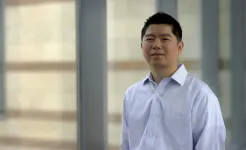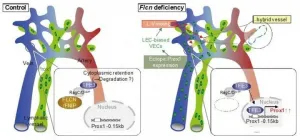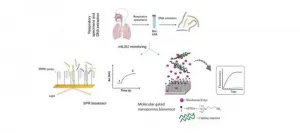Cherenkov imaging makes radiation treatment a visual process. The Cherenkov effect occurs when photon or electron radiation beams interact with tissue, such as skin, producing a small light emission from the surface. BeamSite cameras can capture images of the treatment-beam shapes in real time, as well as show levels of intensity that are proportional to the radiation dose. These visual data can be used to verify both accuracy of dose and of beam delivery at each daily treatment, a verification not possible using standard quality assurance measures.
"Cherenkov imaging provides visualization of the radiation therapy treatment, so that the treatment team can see everything, and make adjustments when unexpected things happen," explains Brian Pogue, PhD, co-director of the Translational Engineering in Cancer Research Program at NCCC, MacLean Professor of Engineering Sciences at Dartmouth Engineering and co-founder of DoseOptics, LLC. A joint engineering and oncology team reviewed events recorded in their Cherenkov imaging study over the course of a few years, during which they documented incidents when radiotherapy delivery was not ideal and the adjustments made to rectify. Their findings, "Initial Clinical Experience of Cherenkov Imaging in External Beam Radiation Therapy Identifies Opportunities to Improve Treatment Delivery," have been published in The International Journal of Radiation Oncology, Biology, Physics.
There were a total of 64 patients in the study, under the supervision of radiation oncologist and lead author Lesley Jarvis, MD, PhD, Member of NCCC's Translational Engineering in Cancer Research Program and Associate Professor of Medicine at the Geisel School of Medicine at Dartmouth. The patients were receiving treatment for breast cancer, sarcoma, lymphoma and other cancers. Six patients were found to indicate that adjustments would have improved treatment, such as stray radiation dose exposure to the opposite breast, arm or chin during breast cancer treatments. The imaging system was also used to identify when inadvertent dose was not an issue, such as confirming no unintended exposure of the opposite leg during an extremity sarcoma treatment.
Radiation therapy is a repetitive procedure given to patients daily for about 30 days. Setting patients up on the treatment couch and daily alignment of the beam is a complex process. Beyond positional complications, the therapy team has to leave the room when the beam is on, so if anything happens during delivery, problem-solving tools are very limited. National statistics show that incidents of incorrect delivery might occur on a level of about 1%. In a busy clinic, this could mean one patient per week. "Normally the treatments are just fine," says Pogue. "However, if you cannot see where the beam is, then it is a blind treatment, and the interaction between patient and therapy team is just less natural than it could be if the treatment was visual."
NCCC is currently the only cancer center in the world with regular use of Cherenkov imaging in all radiotherapy treatments, and was uniquely positioned for clinical research teams to test out these cameras for the planned study. Cherenkov imaging cameras have been installed in most linear accelerators within Dartmouth-Hitchcock, providing an extra level of safety during each patient's therapy session. "Cherenkov cameras mounted inside the radiotherapy treatment rooms give us the ability to simply see the treatment and provide an intuitive guide to therapists that we otherwise wouldn't have had," says Pogue. "This is a terrific tool for tracking what happens each day and in each treatment, and for improving the quality of radiotherapy delivery."
DoseOptics' technology was developed through research at Dartmouth by Dartmouth faculty, who then licensed the product to the company. Pioneered at Dartmouth-Hitchcock, it is now expanding to other cancer centers. Since DoseOptics, LLC, received FDA clearance to market BeamSite in December of 2020, the team hopes all radiation oncology clinics will introduce the technology to their programs. "Clinics should have all the tools available to them to ensure that each treatment for each patient is accurate, and to be able to quickly notice issues and fix them," says Pogue.
INFORMATION:
Brian W. Pogue, PhD, is Co-Director of the Translational Engineering in Cancer Research Program at Dartmouth's and Dartmouth-Hitchcock's Norris Cotton Cancer Center, MacLean Professor of Engineering at Dartmouth Engineering, Professor of Surgery at Geisel School of Medicine at Dartmouth, and President and Co-Founder of DoseOptics, LLC, which develops camera systems and software for radiotherapy imaging of Cherenkov light for dosimetry. His research interests include optics in medicine, biomedical imaging to guide cancer therapy, molecular-guided surgery, dose imaging in radiation therapy, Cherenkov light imaging, image-guided spectroscopy of cancer, photodynamic therapy, and modeling of tumor pathophysiology and contrast.
About Norris Cotton Cancer Center
Norris Cotton Cancer Center, located on the campus of Dartmouth-Hitchcock Medical Center (DHMC) in Lebanon, NH, combines advanced cancer research at Dartmouth College's Geisel School of Medicine in Hanover, NH with the highest level of high-quality, innovative, personalized, and compassionate patient-centered cancer care at DHMC, as well as at regional, multi-disciplinary locations and partner hospitals throughout NH and VT. NCCC is one of only 51 centers nationwide to earn the National Cancer Institute's prestigious "Comprehensive Cancer Center" designation, the result of an outstanding collaboration between DHMC, New Hampshire's only academic medical center, and Dartmouth College. Now entering its fifth decade, NCCC remains committed to excellence, outreach and education, and strives to prevent and cure cancer, enhance survivorship and to promote cancer health equity through its pioneering interdisciplinary research. Each year the NCCC schedules 61,000 appointments seeing nearly 4,000 newly diagnosed patients, and currently offers its patients more than 100 active clinical trials.
About Dartmouth-Hitchcock Health
Dartmouth-Hitchcock Health (D-HH), New Hampshire's only academic health system and the state's largest private employer, serves a population of 1.9 million across northern New England. D-H provides access to more than 2,000 providers in almost every area of medicine, delivering care at its flagship hospital, Dartmouth-Hitchcock Medical Center (DHMC) in Lebanon, NH. DHMC was named again in 2020 as the #1 hospital in New Hampshire by U.S. News & World Report, and recognized for high performance in 9 clinical specialties and procedures. Dartmouth-Hitchcock also includes the Norris Cotton Cancer Center, one of only 51 NCI-designated Comprehensive Cancer Centers in the nation; the Children's Hospital at Dartmouth-Hitchcock, the state's only children's hospital; affiliated member hospitals in Lebanon, Keene, and New London, NH, and Windsor, VT, and Visiting Nurse and Hospice for Vermont and New Hampshire; and 24 Dartmouth-Hitchcock clinics that provide ambulatory services across New Hampshire and Vermont. The D-H system trains nearly 400 residents and fellows annually, and performs world-class research, in partnership with the Geisel School of Medicine at Dartmouth and the White River Junction VA Medical Center in White River Junction, VT.






